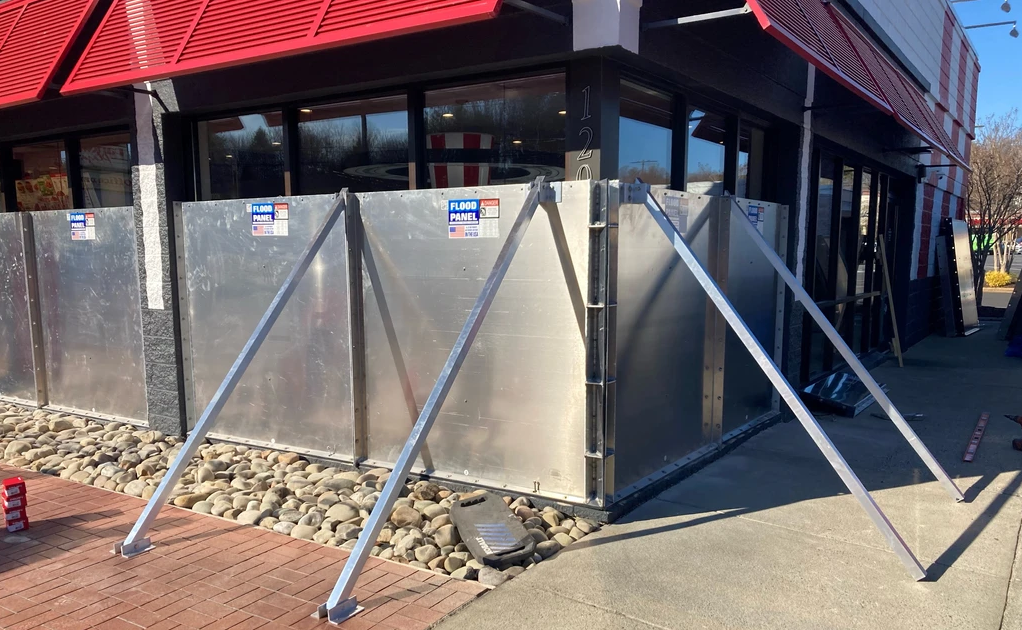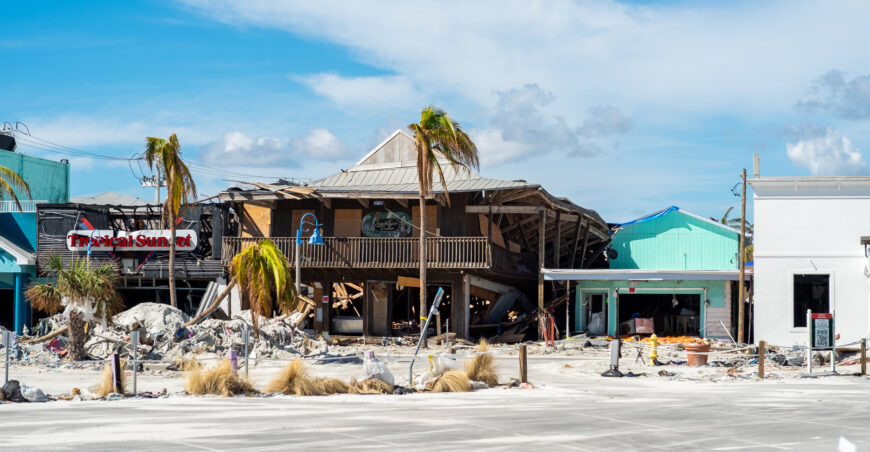In recent years, climate change has increasingly become a critical factor in shaping real estate markets globally. Extreme weather events like hurricanes, floods, wildfires, and rising sea levels are not just disrupting lives – they are also having a profound impact on commercial real estate market and property value. Investors, developers, and homeowners alike are finding that properties located in high-risk areas are losing value, while those situated in safer locations are gaining a premium. This shift reflects a growing awareness that climate risk is not just an environmental issue but an economic one. In this article, we’ll explore how different types of climate risks are influencing property values, the evolving strategies of developers and investors, and how climate adaptation efforts are shaping the future of real estate.
The Spectrum of Climate Risks Impacting Property Values
Hurricanes
Hurricanes pose a significant threat to property values, particularly in coastal regions of the United States such as Florida, Texas, and the Gulf Coast. These areas are vulnerable to high winds, storm surges, and flooding, all of which can cause catastrophic damage to properties. Properties located in hurricane-prone areas are seeing a decline in value as investors and homeowners become more cautious. Areas that are repeatedly hit by hurricanes or that face rising sea levels are becoming less attractive, leading to lower demand and a decrease in property prices. The cost and availability of insurance play a crucial role in determining property values in hurricane-prone areas. As the frequency and severity of hurricanes increases, insurance companies are raising premiums or even withdrawing coverage from high-risk zones.
Additionally, mortgage lenders are becoming more cautious about financing properties in these high-risk areas, adding another layer of difficulty for potential buyers. Commercial real estate investors are increasingly factoring climate risk into their decision-making processes. This is particularly evident in markets such as Miami and other parts of Florida, where investors are seeking to diversify their portfolios away from coastal assets and into inland properties that are less prone to climate risks.
Hurricane Milton and Helene, The latest storm to devastate Florida, serves as a stark reminder of the growing climate risks facing coastal properties. With severe flooding, high winds, and widespread damage, the hurricane has already begun impacting property values as insurers raise premiums and investors grow wary of coastal assets. This event underscores the urgent need for resilient building practices and adaptive strategies in Florida’s real estate market.
Wildfires and Drought
Wildfires, particularly in the western United States, have also become a major concern. Regions like California, Colorado, and Oregon are experiencing increasingly severe and frequent wildfires, which have devastating effects on property values. Homes situated near wildland-urban interfaces (WUIs), where residential development meets natural areas, are at the highest risk. These properties often lose significant value after major wildfire events, as both the immediate damage and long-term risk perceptions deter buyers and investors.
Additionally, prolonged droughts are impacting property values, particularly in agricultural regions and areas reliant on consistent water supply. As water scarcity becomes more pronounced, properties in these regions may face devaluation, while stricter water regulations could also limit development opportunities.
Heatwaves and Rising Temperatures
The rise in global temperatures is another factor influencing property values. In the hotter areas or states, higher temperatures can strain energy infrastructure, increase cooling costs, and create health risks, which in turn diminish property desirability. Moreover, heatwaves have led some municipalities to implement regulations on outdoor construction and activities, further complicating development and adding costs to projects. As a result, investors are becoming more cautious about buying properties in areas that are likely to experience extreme temperature fluctuations.
Economic Consequences of Climate Risks
The influence of climate risk on property values extends beyond the immediate areas affected by disasters. It has broader economic implications that shape market dynamics across regions:
Insurance Costs and Accessibility
Insurance companies are playing a critical role in how climate risks affect property values. In high-risk zones – whether it’s coastal areas prone to hurricanes, regions susceptible to floods, or locations facing wildfire threats – insurance premiums are rising dramatically. In some cases, insurers are even withdrawing coverage, leaving homeowners and businesses with fewer options and higher costs. These rising insurance expenses directly impact property affordability and desirability, often deterring buyers and reducing property values.
Mortgage Lending Challenges
Mortgage lenders are becoming increasingly cautious about properties in high-risk areas. In response to climate risk, many lenders now require higher down payments or charge increased interest rates for properties in vulnerable locations. Some lenders may even refuse to finance properties without adequate insurance coverage, which becomes problematic in areas where insurers have pulled out. As lending becomes more restrictive, the pool of potential buyers shrinks, further reducing demand and driving down property prices.
Reduced Investor Confidence
The commercial real estate sector is heavily influenced by investor confidence, especially in regions most exposed to climate risks. Investors who seek long-term stability are increasingly diversifying away from high-risk zones, such as coastal areas prone to hurricanes or regions in the western United States susceptible to wildfires. Instead, they are shifting their focus to inland or higher-altitude locations with a lower risk of climate-related disruptions. As a result, these safer areas are seeing an uptick in property values, while high-risk areas experience a decline.
The Role of Adaptation and Resilience in Property Value Preservation

With climate risks becoming a central consideration in real estate, developers and policymakers are exploring ways to mitigate these impacts. Climate resilience and adaptation strategies are becoming critical for protecting and enhancing property values in vulnerable areas.
Resilient Building Practices
Developers are increasingly adopting resilient construction techniques to protect properties from extreme weather events. This includes using fire-resistant materials in wildfire-prone areas, elevating buildings in flood zones, and implementing wind-resistant designs in hurricane-prone regions. In cities like Miami, for example, new building codes require structures to withstand higher wind speeds and flooding scenarios, helping to reduce the long-term risks associated with hurricanes. These measures not only protect properties but also help stabilize or even enhance property values by demonstrating proactive risk management.
Urban Planning and Zoning Regulations
Governments and municipalities are playing a vital role in adapting urban planning strategies to mitigate climate risks. This includes establishing zoning regulations that restrict development in high-risk areas or require specific resilience measures, such as maintaining green spaces that act as natural flood barriers. While these measures may increase short-term costs for property owners through taxes or special assessments, they ultimately aim to protect long-term property values and attract investors back to at-risk areas.
Technological Innovation and Climate Data
Technology is increasingly being leveraged to manage and mitigate climate risks. Predictive modeling and Geographic Information Systems (GIS) tools allow developers, investors, and insurers to better assess climate vulnerabilities. For example, AI-driven platforms that incorporate data on flooding, wildfire risks, and temperature changes are helping real estate professionals identify safer investment opportunities. These technologies also guide developers in designing and constructing resilient properties that can withstand future climate events, thus maintaining or increasing their value.
Climate risk is fundamentally altering the real estate market, influencing property values across various regions and property types. Flooding, wildfires, hurricanes, and heatwaves all pose unique threats that devalue properties in high-risk areas while simultaneously creating opportunities for growth in safer locations. As climate events become more frequent and severe, property owners, investors, and developers must adapt by adopting resilience strategies, leveraging technology, and supporting proactive urban planning. Understanding the risks and preparing for the future can help the real estate industry mitigate the financial impacts of climate change, ensuring that property values are protected, and investments remain viable in the long term.
If you’re interested in gaining deeper insights into how climate risks are affecting commercial real estate, or if you need guidance on adapting your investment strategy, the ICRE Investment Team is here to assist. Whether you’re looking for market data, property information, or connections in areas like lending, investment, brokerage services, or consulting, feel free to reach out to us. We’re committed to supporting your commercial real estate needs.
















